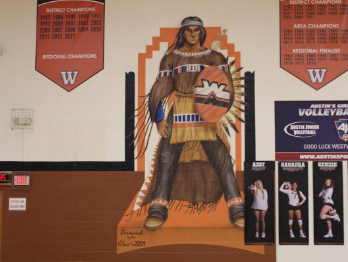At the end of each day at Westwood, a loud and distinctive song blares through the hallways. Although it can represent the end of a long school day for many exhausted students, the fierce and proud melody is hard to ignore.
It’s a war cry.
School mascots have always been used for a variety of reasons, such as performing at events, creating a symbol for a diverse community to unite under, and representing unique identifying features of the surrounding area. When you think of a college or sports team, the mascot is often the first thing that pops into your head. Needless to say, mascots play a large role in the representation of an organization. But when you make your school mascot an ethnicity, you have to consider whether or not it’s ethical to portray the ethnicity that you claim represents you.
Westwood’s controversial warrior mascot, which has long been associated with Indigenous people, has been part of the school since the very beginning. Although it is not clear who was responsible for the decision, it is used today in many instances throughout the school. A large, noticeable painting of an Indigenous person looms on the wall of the gym. At football games, football players run out of teepees, their dramatic emergence accompanied by clouds of steam. A glass mosaic near the front entrance depicts an Indigenous individual with feathers coming out of his head. T-shirts with logos of Indigenous people are abundant throughout the school’s population. But by far the most prevalent example of the Westwood representation of Indigenous culture is the “fight song” that plays every day after school. The tune is deeply ingrained into my memory. As a freshman, I didn’t know what it represented. But now the connection between the energetic notes and the school mascot seems too obvious to overlook.
“[The fight song] is an anthem that evokes visions of charging into battle,” an anonymous faculty member said. “If I was out in public, like if I was out at a festival or something like that, and I heard that song, my mind would go to, ‘I bet they have Indigenous wares or food.’”
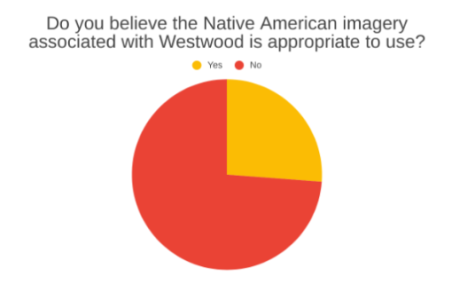
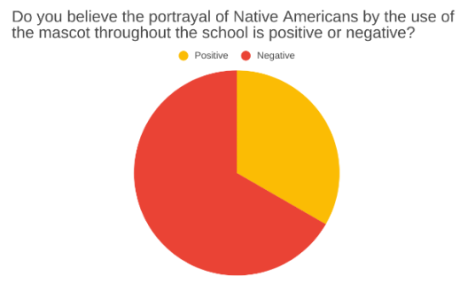
The student body has had somewhat conflicting opinions on this topic. Of the students who responded to a poll about the school mascot, 73.8% believe the Indigenous imagery associated with Westwood is not appropriate to use, and 66.7% believe that the portrayal of Indigenous culture throughout the school paints them in a negative light.
“By having the name ‘Warriors’ and the very intense-looking mascot with the tribal headdress, the school is perpetuating the dangerous stereotype that all Indigenous people are ‘savages,” Nyx Schexnayder ‘23 said. “It is not our place as a school to use [an Indigenous mascot] in the first place.”
On its own, the warrior mascot is not offensive. However, its Indigenous aspects portray Indigenous people as violent and warlike, especially considering the long history of colonization and genocide committed against Indigenous groups.
“Last year I took AP World History and this year I’m taking AP US History, and from what I’ve learned, Native culture is extremely diverse,” Allie Dodero ‘23 said. “I think our school spreads a lot of stereotypes about Native groups and generalizes the complexity of the culture. If we continue to accept racism, especially in a school that claims to value its diverse student body, we’re going against our core values and we’re a part of the problem.”
Not all students agree. Some believe that it is important to preserve Indigenous culture by keeping Indigenous-related imagery and terms around the school.
“To learn about and immerse yourself in another culture is a positive thing,” an anonymous student said. “[Indigenous people are] showcased as strong and resilient people, Warriors, just as the school wishes the students would feel. To change or remove that representation would arguably be more racist than having a strong native warrior as our mascot in the first place. There is no negative representation or appropriation there, just a celebration of a culture.”
It’s true that Indigenous people have been portrayed as strong and resilient, but again, there are negative traits woven into that representation. One way for Westwood to positively celebrate Indigenous culture would be to educate students about the customs and traditions of specific tribes, rather than using Indigenous culture as a logo.
A portion of the students who answered that the Indigenous imagery and terms should be kept argued that it’s just a mascot. However, this claim overlooks the impact the mascot’s usage has on an entire culture. Despite the variety of perspectives that surrounds this issue, it is important to remember that neither side in this ongoing debate deserves hatred or disrespect.
“It’s not that anybody means to perpetuate racism,” Ms. Saenz said. “The actions are careless, not the people. I think it’s important for all sides to recognize that people mean well. We can disagree strongly. But we don’t need to tear each other down.”
In the past, Westwood had a Indigenous staff member who would take school design ideas to a Indigenous council group in the area. The council would then review the designs and decide whether they were respectful or not, according to history teacher Ms. Kelly Saenz, who has been teaching at Westwood for over 30 years. But some of the designs the council approved wouldn’t be viewed as generously today, according to Ms. Saenz. For example, one suggestion from the council was the “flying eagle” award, which was used to honor teachers and show respect for them, because eagles were special to Indigenous culture.
Society has evolved since then, and with an increase in societal awareness comes change. According to Coach Travis Dalrymple, who was a student at Westwood in the late 90s, there used to be a cheerleader at Westwood who would dress up in traditionally Indigenous attire and attend all of the football and basketball games. This tradition was popular with the students at the time. All of the football helmets had depictions of an Indigenous individual on them, and imagery of bows, arrows, and feathers – all items often associated with Indigenous culture – were commonly displayed throughout the school.
Community complaints have reduced the appearances of these items. Nowadays, most of the uses of the Westwood Warriors logo feature a much less controversial symbol: a large, burnt-orange W.
“I think [complaints about the mascot] came from students more than anyone else. There were faculty who certainly felt the same way,” Ms. Saenz said. “It’s not about defending who we were. All societies change. We used to have slavery in this country. We don’t have slavery anymore. Do we have racism? We know we do. We’re an imperfect society. What are we trying to be? A better society. It’s a path. It’s not one day to the next. I think [change] comes from students. I think it has to. If it comes from adults, it comes from the outside.”
Many sports teams with Indigenous names and mascots have followed the widespread trend of changing their outdated monikers. Teams such as the Washington Commanders and Cleveland Guardians dropped their previous names after facing criticism.
If entire sports franchises are taking steps to remove or replace their controversial logos and mascots, there is little stopping Westwood to do the same – because Indigenous people aren’t mascots. They’re people. Westwood needs to begin its disassociation with Indigenous culture as a mascot and remove Indigenous imagery from its halls. In order to further distance itself from its inappropriate use of culture, Westwood can consider replacing its “warrior” component entirely. Suggestions from the student body for alternate mascots include the wizards, wombats, wolves, whalesharks, wildcats, wasps, and woodpeckers. If the “warrior” name is kept, there are options for alternate imagery such as an armor-clad knight, which is much less controversial and changes the connotation of the mascot’s use.
“I’m part Mexican,” Ms. Saenz said. “If a school used, as some in Texas use, stereotypical versions of Mexican Americans as a mascot, I don’t know if I could even express how infuriating it would be. Nobody wants their ethnicity, their national group, their culture, chosen as somebody else’s mascot.”
Westwood’s mascot is officially a warrior. But Indigenous-related imagery adorns T-shirts and walls. The fight song still plays every day after school. And as long as they remain, controversy will linger.
This story was originally published on Westwood Horizon on October 26, 2022.
















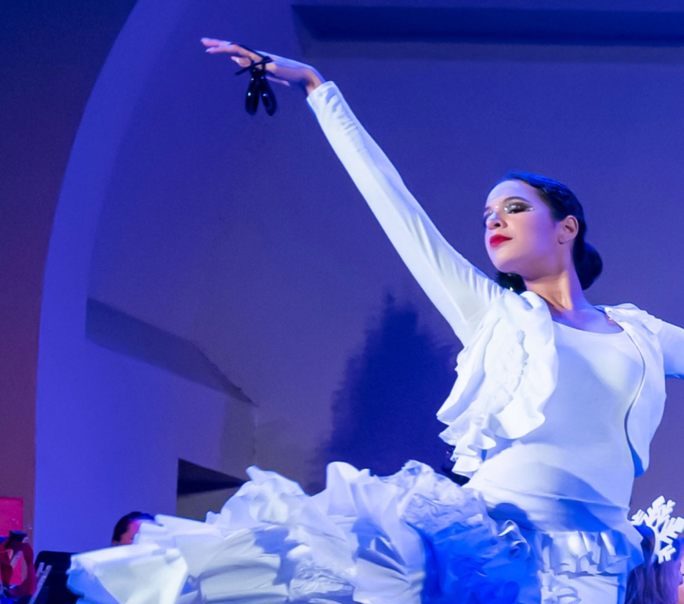
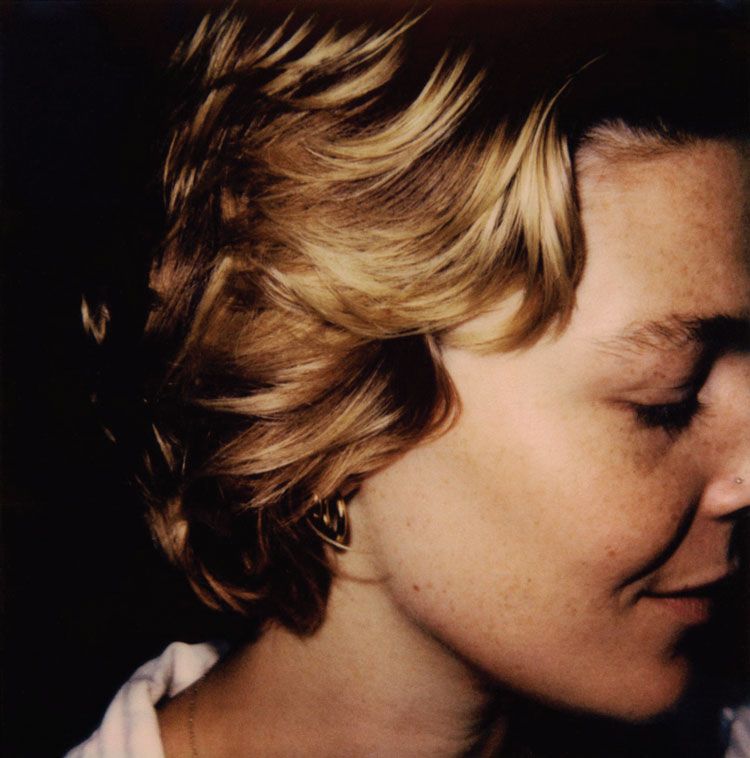













![IN THE SPOTLIGHT: Junior Zalie Mann performs “I Love to Cry at Weddings,” an ensemble piece from the fall musical Sweet Charity, to prospective students during the Fine Arts Showcase on Wednesday, Nov. 8. The showcase is a compilation of performances and demonstrations from each fine arts strand offered at McCallum. This show is put on so that prospective students can see if they are interested in joining an academy or major.
Sweet Charity originally ran the weekends of Sept. 28 and Oct. 8, but made a comeback for the Fine Arts Showcase.
“[Being at the front in the spotlight] is my favorite part of the whole dance, so I was super happy to be on stage performing and smiling at the audience,” Mann said.
Mann performed in both the musical theatre performance and dance excerpt “Ethereal,” a contemporary piece choreographed by the new dance director Terrance Carson, in the showcase. With also being a dance ambassador, Mann got to talk about what MAC dance is, her experience and answer any questions the aspiring arts majors and their parents may have.
Caption by Maya Tackett.](https://bestofsno.com/wp-content/uploads/2024/02/53321803427_47cd17fe70_o-1-1200x800.jpg)
![SPREADING THE JOY: Sophomore Chim Becker poses with sophomores Cozbi Sims and Lou Davidson while manning a table at the Hispanic Heritage treat day during lunch of Sept 28. Becker is a part of the students of color alliance, who put together the activity to raise money for their club.
“It [the stand] was really fun because McCallum has a lot of latino kids,” Becker said. “And I think it was nice that I could share the stuff that I usually just have at home with people who have never tried it before.”
Becker recognizes the importance of celebrating Hispanic heritage at Mac.
“I think its important to celebrate,” Becker said. “Because our culture is awesome and super cool, and everybody should be able to learn about other cultures of the world.”
Caption by JoJo Barnard.](https://bestofsno.com/wp-content/uploads/2024/01/53221601352_4127a81c41_o-1200x675.jpg)





